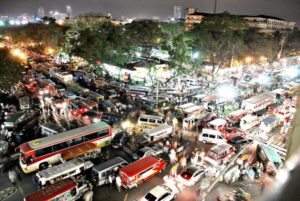
Negative Effects of Traffic on Property Values and Land Usage
Traffic congestion has cost the economy quite heavily in terms of the slowdown in the movement of goods and delivery of services, increased vehicle operating costs, and otherwise productive man-hours consumed as travel time.
Metro Manila and other major cities are experiencing major traffic congestion because the high economic and population growth in the last decade was not accompanied by proportionate and timely investment in infrastructure. In the last four years, the government fell short of its planned infrastructure spending by an average of PHP50 billion per year or roughly $1.1 billion. A number of public-private partnership (PPP) projects have also been delayed at various stages from planning to implementation. In particular, the much-needed LRT-MRT common station has been delayed for five years now since inception as the two operators have yet to agree on where to build it.
Metro Manila is significantly populated. Its streets are filled with both public and private vehicles that contribute to congestion. The effects caused by clogged streets and highways are obvious nowadays – people arrive at their homes late, there is a major increase in transportation costs, and loss of precious time. These consequences should open the eyes of the government to take drastic actions to solve the problem that causes our country to crumble.
Just like the other fields in the country, the real estate industry suffers from heavy traffic and poor transportation system in many ways. From buyers to sellers and developers to marketers, everyone is affected.
The value of a property depreciates when it is located in flood-prone and traffic-congested areas. Good thing accessibility also greatly increases its value. The chances of it being sold also increase. If it can be easily accessed, its worth goes up no matter what.
Traffic congestion can have different effects on the values of different properties, for example, it has a positive effect for commercial establishments because of more public exposure while it can have negative effects for residential and industrial properties. Base on the study of Bateman, Day, Lake and Lovett, road traffic has an effect on residential property values due to road noise. Their first aim was satisfied by using hedonic pricing1` study, which relates current property prices to a wide range of factors that may affect the price. They included variables related to structure, neighborhood, accessibility, and environment of the property in addition to variables relating to the
impacts of nearby roads. They used a noise modeling software to calculate the change in noise level. Their study found that property prices were depressed by 0.20% for each decibel increase in road noise.
According to the Southern California Particle Center and Supersite (SCPCS), the closer people are to the source of traffic emissions, the higher their exposure is to many of the constituents of exhaust. Compelling evidence suggests that people living, working, and going to school near roads with heavy traffic may have an increased risk of adverse health effects associated with exposure to mobile source pollution. These “traffic density” studies have observed development and increased aggravation of asthma, decreased lung function in children, and low birth weight and premature births for mothers living near major roads.
Taking this risks into consideration, its easy to see why new homebuyers are concerned with how close the property is to a busy road or highway. European studies have shown increased respiratory health problems in children who live or go to school within 100 meters of a busy roadway, with the greatest risks appearing in the first 50 meters.
Carey’s report backed up this underlying risks saying that detached single-family homes were negatively impacted by its proximity to the highway. The negative effects on sale prices were greatest for homes closest to the highway, but a reduction in property values was also observed. Price appreciation was lower indicating that negative impacts were not transitory but lasting.
As for the industrial industry, the saying that time is money is certainly the case for them. They would not want to invest in a property near road traffic because delivering finished goods or receiving raw materials or inventory is time sensitive. Delays affect production, delivery and work schedules, take its toll on the bottom line of the company. It could also have an adverse impact on market demand, where alternative suppliers from other countries are more readily able to provide products at more reliable delivery schedules.
While total reduction of congestion is next to impossible in the Philippines, consistent and serious efforts to improve transportation infrastructure for Metro Manila including much delayed mass transport systems can translate to genuine benefits. Such benefits include increased productivity and perhaps a healthier metropolitan population who have to contend with less stress and air pollution.
The business community in the Philippines is all for investing on transportation infrastructure to reduce congestion and lower costs associated with traffic jams. Continued procrastination over road and other infrastructure projects that should have been implemented long before will only leader to higher productivity losses.
_________________________________________________________________________________________________________________________
References
Bateman, I., Day, B., Lake, I., Lovett, A. (2001). The Effect of Road Traffic on Residential Property Values: A Literature Review and Hedonic Pricing Study. Retrieved from http://www.gov.scot/resource/doc/158818/0043124.pdf
Carey, J. (2001). Impact of Highway on Property Values: Case Study of the Superstition Freeway Corridor. Retrieved from http://ntl.bts.gov/lib/24000/24800/24842/AZ516.pdf
Southern California Particle Center and Supersite. Retrieved from http://www.scpcs.ucla.edu/news/Freeway.pdf











